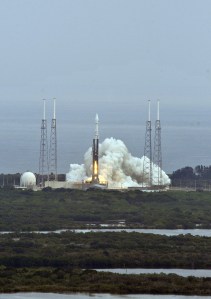
The oncoming storm prompted a delay in the planned launch Thursday of a powerful rocket carrying a mysterious U.S. spy satellite from Vandenberg Air Force Base.
The Atlas V 541 rocket had been expected to blast off from the Lompoc-area base at 7:17 p.m., the 30th Space Wing announced earlier this week. The launch was rescheduled for 7:13 p.m. Friday.
The rocket is the same kind that launched NASA’s Curiosity Mars rover in 2011, according to the system’s maker, United Launch Alliance.
The 20-story rocket will be the most powerful ever launched from Vandenberg AFB, SpaceFlightNow.com reported.
Preparations at the base’s Space Launch Complex-3 had been going ahead as of 12:30 p.m., according to SpaceFlightNow.com.
Just before 2 p.m., United Launch Alliance announced on Twitter that the launch would be scrubbed due to weather. The launch was rescheduled for 7:13 p.m. Friday, when there was expected to be a 40 percent chance of favorable weather, the company stated.
In response to questions about the weather’s effects on its launch, United Launch Alliance stated on its Facebook page Thursday morning that it would work with the 30th Space Wing “to ensure that conditions are right for a safe, successful mission.”
The launch’s four solid rocket boosters could leave a visible trail over Southern California, though clouds may obscure the view.
The rocket was set to deliver a satellite into orbit for the National Reconnaissance Office, a federal agency responsible for building and operating intelligence satellites.
The exact mission of NROL-35 was unknown but was described by United Launch Alliance as being “in support of national defense.”
The Atlas V-541 stands about 196 feet tall or about 20 stories; fully fueled it weighs more than a million pounds. #NROL35
— NRO (@NatReconOfc) December 11, 2014
Payload was mated to the Atlas V-541 booster on Nov. 22. #NROL35 (ULA photos) @NatReconOfc @ulalaunch @30thSpaceWing pic.twitter.com/XDN6U7H04f
— NRO (@NatReconOfc) December 11, 2014
The countdown has begun for tonight's Atlas 5 launch from Vandenberg AFB in California. http://t.co/UqTSIzVkV6 pic.twitter.com/8rlPn81hNC
— Spaceflight Now (@SpaceflightNow) December 11, 2014





